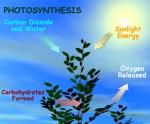|
This section contains 973 words (approx. 4 pages at 300 words per page) |

|
Photosynthesis is the biological conversion of light energy into chemical energy. This occurs in green plants, algae, and photosynthetic bacteria.
Much of the early knowledge of bacterial photosynthesis came from the work of Dutch-born microbiologist Cornelius van Neil (1897-1985). During his career at the Marine Research Station in Monterey, California, van Neil studied photosynthesis in anaerobic bacteria. Like higher plants, these bacteria manufacture carbohydrates during photosynthesis. But, unlike plants, they do not produce oxygen during the photosynthetic process. Furthermore, the bacteria use a compound called bacteriochlorophyll rather than chlorophyll as a photosynthetic pigment. Van Neil found that all species of photosynthetic bacteria require a compound that the bacteria can oxidize (i.e., remove an electron from). For example, the purple sulfur bacteria use hydrogen sulfide.
Since van Neil's time, the structure of the photosynthetic apparatus has been deduced. The study of photosynthesis is currently an active area of...
|
This section contains 973 words (approx. 4 pages at 300 words per page) |

|


